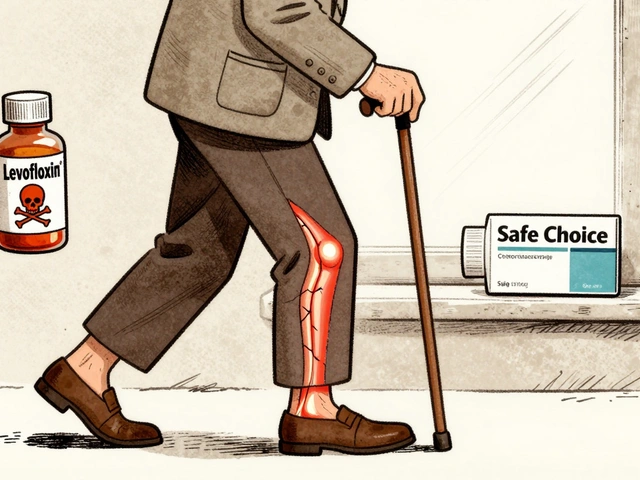Catamenial Epilepsy Pattern Tracker
Your Hormonal Seizure Pattern
Perimenstrual Low Progesterone, Falling Estrogen
Timing: Days -2 to +3 of menstruation
Seizure Change: +30-50%
Periovulatory Estrogen Peak
Timing: Days 12-16 (around ovulation)
Seizure Change: +20-40%
Luteal Progesterone Drop
Timing: Days 26-28 (pre-menstruation)
Seizure Change: +10-30%
Ever notice that your seizures seem to cluster around certain days of your period? You’re not alone. Many women with epilepsy experience a clear link between their menstrual cycle and the way their brain fires. This article breaks down why hormones matter, how to spot patterns, and what you can do to keep seizures under control.
What Is catamenial epilepsy?
Catamenial epilepsy a subtype of epilepsy where seizure frequency changes predictably with the menstrual cycle affects roughly 10‑20% of women with epilepsy. The term comes from the Greek “catamenia,” meaning monthly. In practical terms, it means that hormone swings during your period can either trigger more seizures or, for some, actually calm the brain.
Hormones 101: Estrogen and Progesterone
Two hormones dominate the menstrual cycle: Estrogen and Progesterone. Estrogen peaks just before ovulation and is known to be excitatory-it can lower the seizure threshold, making the brain more likely to fire. Progesterone, on the other hand, rises after ovulation and has a calming effect because it converts into neurosteroids like allopregnanolone, which boost GABA activity (the brain’s main inhibitory signal).
Understanding this back‑and‑forth is key because the timing of each hormone’s rise and fall creates three classic windows where seizures can change.
Typical Patterns of Hormone‑Related Seizure Changes
Researchers categorize the timing into three patterns:
| Pattern | Hormone Dominance | Typical Timing in Cycle | Seizure Change (%) |
|---|---|---|---|
| Perimenstrual | Low progesterone, falling estrogen | Days-2 to+3 of menstruation | +30‑50% |
| Periovulatory | Estrogen peak | Days12‑16 (around ovulation) | +20‑40% |
| Luteal | Progesterone drop (late luteal) | Days26‑28 (pre‑menstruation) | +10‑30% |
These numbers come from multiple prospective studies that followed women for at least six months. Not every woman fits neatly into a single pattern; some experience a blend, while others see no clear link.
How to Detect Your Personal Pattern
Detecting a pattern starts with systematic tracking. A seizure diary that records seizure type, severity, and timing alongside menstrual details (first day of bleed, ovulation tests, mood) is the gold standard. Many free apps let you tag each entry with a hormone‑related note, making later analysis a breeze.
- Log every seizure, even if it feels minor.
- Mark day1 of your period, note any spotting, and record ovulation test results if you use them.
- At the end of the month, look for clusters that line up with the three windows above.
If you see a 2‑fold increase in seizures during the perimenstrual window, you’ve likely got a perimenstrual pattern.

Medical Options to Tame Hormone‑Driven Seizures
Once you’ve identified a pattern, there are several evidence‑based routes.
- Adjust Antiepileptic Drugs (AEDs): Some clinicians add a short course of benzodiazepines or increase the dose of a baseline AED during the high‑risk days. Antiepileptic drug levels can be checked before the expected surge to see if a tweak is needed.
- Hormonal Contraceptives: Hormonal contraceptive pills that provide steady estrogen and progestin can flatten the natural peaks. Continuous‑use regimens (no hormone‑free interval) are particularly helpful for perimenstrual patterns.
- Progesteronesupplementation: Natural progesterone (micronized) taken during the luteal phase has shown seizure‑reducing effects in small trials, especially for women whose seizures worsen when progesterone drops.
- Neurosteroid therapy: Newer agents likeallopregnanolone analogs are under investigation and may become options for refractory catamenial epilepsy.
- Non‑pharmacologic measures: Adequate sleep, stress management, and magnesium supplementation can blunt hormone‑induced excitability.
Always discuss any changes with a neurologist familiar with gender‑specific epilepsy. Hormone‑based treatments can interact with AEDs, altering blood levels.
Practical Lifestyle Tips
Even without medication tweaks, a few everyday habits can reduce seizure spikes.
- Consistent sleep schedule: Aim for 7‑9hours; irregular sleep is a known seizure trigger that can amplify hormonal effects.
- Stress‑relief routines: Yoga, meditation, or a short walk can lower cortisol, which otherwise contributes to seizure susceptibility.
- Balanced diet: Keep blood sugar stable. Low‑glycemic carbs and omega‑3‑rich foods (fish, flaxseed) support brain health.
- VitaminB6 and magnesium: Some women report fewer seizures when these minerals are adequate; a daily 200‑300mg magnesium citrate is a common starting dose.
- Use of reliable ovulation kits: Knowing the exact day of estrogen peak helps you anticipate the peri‑ovulatory window.
When to Call Your Doctor
If you notice any of the following, seek professional advice promptly:
- Seizure frequency doubles or more during a particular phase.
- New seizure types appear (e.g., focal to generalized conversion).
- Side effects from hormone therapy (weight gain, mood swings) become problematic.
- Difficulty tracking symptoms due to cognitive fatigue.
A neurologist can run hormone panels, adjust AED regimens, and refer you to an endocrinologist if needed.
Key Takeaways
- Catamenial epilepsy is a real, hormone‑linked condition that affects up to one in five women with epilepsy.
- Estrogen tends to raise seizure risk, while progesterone (and its neurosteroid derivatives) usually lowers it.
- Track seizures and menstrual phases meticulously to pinpoint your personal pattern.
- Therapeutic options include AED dose timing, hormonal contraceptives, progesterone supplements, and lifestyle tweaks.
- Regular follow‑up with a specialist ensures safe, effective management.
Frequently Asked Questions
What exactly defines catamenial epilepsy?
It is a form of epilepsy where seizure frequency or severity consistently changes in sync with the menstrual cycle, usually increasing during specific hormonal windows.
How long does it take to see a pattern?
Most clinicians recommend at least three consecutive cycles of careful logging. That gives enough data to spot a 20‑30% increase that’s statistically meaningful.
Can birth control pills cure catamenial epilepsy?
They don’t cure the underlying epilepsy, but continuous‑use hormonal contraceptives can smooth out estrogen peaks and reduce seizure spikes for many women.
Are there risks to adding progesterone supplements?
Potential side‑effects include drowsiness, mood changes, and rare interactions with certain AEDs that affect liver enzymes. Always start under a doctor’s supervision.
What non‑drug methods work best?
Consistent sleep, stress‑reduction techniques, a balanced diet rich in magnesium and omega‑3s, and precise seizure‑menstrual tracking are the most evidence‑backed lifestyle tools.










This shit is just another excuse for us to medicate everything
The nuanced interplay between estrogenic peaks and neuronal excitability has been a subject of scholarly discourse for decades.
The perimenstrual window, characterized by a precipitous decline in progesterone, engenders a milieu conducive to ictogenesis.
Conversely, the periovulatory phase, wherein estradiol surges, is not merely a hormonal crescendo but a catalyst for synaptic potentiation.
Such physiological oscillations do not occur in a vacuum; they are modulated by individual pharmacokinetics and comorbidities.
A rigorous three‑month log, as advocated by the authors, furnishes the granularity requisite for pattern elucidation.
Statistical correlation, however, does not equate to causation, a distinction that the lay reader often neglects.
The presented interface, though aesthetically commendable, suffers from a paucity of adaptive algorithms.
Future iterations might integrate machine‑learning models to predict seizure propensity with greater fidelity.
Moreover, the omission of a control cohort undermines the external validity of the findings.
It is incumbent upon clinicians to juxtapose these digital insights with electroencephalographic data.
Patients, too, must be counseled regarding the stochastic nature of hormonal fluctuations.
A holistic approach, encompassing lifestyle interventions, may attenuate the observed seizure amplification.
One should also consider the psychosocial stressors that concomitantly influence endocrine balance.
Thus, while the tool represents a step forward, it remains an adjunct rather than a panacea.
In summation, a multidimensional strategy, anchored in both neurophysiology and patient empowerment, is paramount.
It is morally indefensible to trivialize the burden that catamenial epilepsy imposes upon women. The clinical community has long ignored the gendered dimension of seizure disorders, thereby perpetuating systemic inequities. One must demand rigorous hormonal profiling as a standard of care, not an optional research curiosity. The ethical imperative extends to ensuring that insurance providers recognize the necessity of adjunctive therapies. In any case, the failure to act constitutes a dereliction of professional duty.
Well, that's not quite right, actually, because the claim overlooks the fact that hormonal fluctuations are merely one of countless variables influencing seizure thresholds, and isolating them as the primary culprit is scientifically untenable
The waxing and waning of hormones reads like a tragic opera within the brain's delicate circuitry. Each menstrual crescendo summons a storm of electrical discharges that threaten to upend daily life. Yet, amidst the turmoil, there lies a resilient hope that knowledge can tame the tempest. One cannot help but feel the sorrowful beauty of this physiological saga.
Tracking cycles alongside seizures can reveal patterns that are otherwise invisible. A disciplined log empowers patients to anticipate high‑risk days. It also provides clinicians with concrete data for tailoring treatment. Simple diligence often yields profound insights.
Absolutely, that kind of consistency can make a huge difference 😊